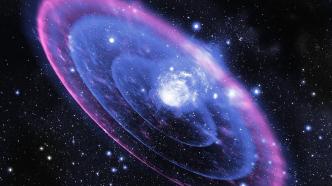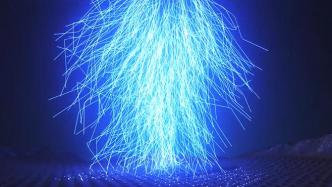
As the most violent celestial explosion phenomenon ever observed in the universe, the details of the gamma-ray burst (or gamma-ray burst) are still foggy. Some studies even claim that it is related to the Ordovician mass extinction.

In the early morning of January 10, 2023, a paper published online in the international academic journal "Nature" reported the oscillation signal detected in two short gamma-ray bursts - a high-frequency quasi-periodic oscillation signal (quasiperiodic oscillations, QPOs).
The title of the paper is "Kilohertz quasiperiodic oscillations in short gamma-ray bursts."
The corresponding author of the paper is Cecilia Chirentii, an associate researcher at the Department of Astronomy at the University of Maryland, College Park, and a visiting scientist at NASA Goddard Space Flight Center.
On the 9th, Cecilia told The Paper that these signals can help us understand how gamma-ray bursts are generated, what neutron stars are made of, and how they merge.
After a medium-sized star (mass about 8-20 times that of the sun) explodes at the end of its life, the remaining material collapses into a dense core, which may become a "strange" neutron star.
Cecilia said that it is generally believed that short gamma-ray bursts that last less than 2 seconds are short gamma-ray bursts, and long gamma-ray bursts that exceed 2 seconds are long. But this is not a strict definition. Short gamma-ray bursts are thought to be produced by the merger of two neutron stars, while long gamma-ray bursts are produced by supernova explosions of massive stars.
But there are still many problems in the field of gamma-ray bursts that need to be studied. Cecilia told ThePaper, for example, what are the details of the process of neutron stars merging to form short gamma-ray bursts? How often does this happen? Can neutron star and black hole mergers also produce short gamma-ray bursts?
The process of two stars merging into a larger object through gravity is called a stellar collision. The generation of short gamma-ray bursts has something to do with it.
Although the above process will also generate gravitational wave signals, Cecilia said that existing gravitational wave detectors are not sensitive enough in the high frequency (>1kHz) range to detect relevant signals.
According to the article published by Wang Ziyang and others quoted on the official website of the Institute of High Energy Physics, Chinese Academy of Sciences, if the mass distribution of a system moves asymmetrically, then the space-time deformation will propagate outward in the form of ripples, which are gravitational waves. Binary star systems emit gravitational waves.
Numerical simulations suggest that supermassive neutron stars may introduce oscillations to gamma-ray bursts resulting from collisions. Cecilia and her colleagues were looking for just such a signal.
By sifting through more than 700 observations in archived data, they found two such signals in observations from the Compton Gamma-ray Observatory. The related gamma-ray bursts are all short, lasting about 10 milliseconds, and contain two oscillation frequencies: ~2.7kHz and ~1kHz.
According to the paper, the detection of these high-frequency quasi-periodic oscillation signals provides a potentially powerful new tool for studying the dynamics and gravity in neutron star mergers.
In addition, it is worth noting that in the field of gamma-ray burst astronomy, Chinese scholars have also continuously achieved research results.
According to the official website of the School of Astronomy and Space Science of Nanjing University, "In previous research work, despite many attempts, evidence of the existence of repetitive time series (such as quasi-periodic signals) in the instantaneous radiation phase of gamma-ray bursts has not yet been confirmed." The Atmosphere-Space Interaction Monitor (ASIM) of the International Space Station has resolved the time structure of quasi-periodic signals on the sub-millisecond time scale in the observation data of high-energy bursts of magnetar gamma-ray bursts, which are 2 kHz and 4 kHz two high-frequency quasi-periodic signals. These signals not only play a vital role in the study of the properties of magnetars in the superflare stage, but also can be used to study their magnetic field changes, starquakes and other phenomena. Related papers were published online in the international academic journal Nature on December 22, 2021. "Teacher Zhang Binbin from Nanjing University and doctoral student Peng Zongkai participated in this international cooperative research."
According to the official website of the Nanjing University Science and Technology Department, the Nanjing University research team discovered the shortest Type II gamma-ray burst in history . The relevant papers were published online in the international academic journal "Nature·Astronomy" on July 26, 2021, with Nanjing University as the first author and first communication unit. "Mr. Zhang Binbin from Nanjing University and Mr. Zhang Bing from the University of Nevada are the corresponding authors of this paper. Graduate students Liu Zike and Peng Zongkai from Nanjing University are the co-first authors of this paper. Peking University, Hebei Normal University, Guangxi University, Yunnan Observatory, Andalusia, Spain Many experts and scholars including the Institute of Astrophysics and the University of Science and Technology of China participated in this research work."
According to the official website of the Institute of High Energy Physics, Chinese Academy of Sciences, at 21:17 on October 9, 2022 (Beijing time), the High Altitude Cosmic Ray Observatory (LHAASO, Lasso), the High Energy Burst Explorer (HEBS) and the Smart Eye satellite simultaneously detected The brightest gamma-ray burst so far is more than 10 times brighter than the brightest gamma-ray burst ever observed by humans. These observations broke the records of multiple gamma-ray burst observations, and are of great value in revealing the eruption mechanism of gamma-ray bursts.
According to the WeChat official account of Nanjing University, on December 8, 2022, a research team led by Zhang Binbin, School of Astronomy and Space Science, Nanjing University, published a paper in the world's top scientific journal "Nature", and discovered a case of special significance in observation The gamma-ray burst GRB 211211A, through detailed data analysis, points out that its progenitor star may be a neutron star-white dwarf merger system. This is the first discovery of a long gamma-ray burst originating from the merger of compact stars with an eruption time much longer than the typical time of a short burst, and it is also the first discovery of a kilonova originating from a long burst.


